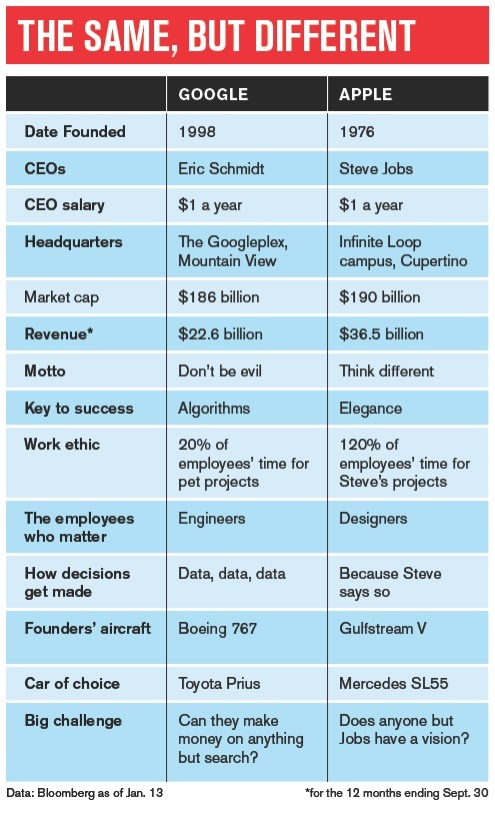The Complex Relationship Between Apple And Google

Table of Contents
Competition: A Battle for Market Dominance
The rivalry between Apple and Google manifests most visibly in their competition for market share across various sectors.
Operating Systems: iOS vs. Android
The mobile operating system (smartphone OS) market is a primary battleground. iOS, powering Apple's iPhones and iPads, and Android, Google's open-source OS powering a vast array of devices, are locked in a continuous struggle for dominance. iOS consistently boasts higher average revenue per user, while Android enjoys a significantly larger global market share. The user demographics also differ significantly; iOS users tend to be located in wealthier nations and skew slightly older than the more globally diverse Android user base.
- Key Differences: iOS is known for its simplicity and user-friendliness, while Android offers greater customization and flexibility.
- App Ecosystems: The App Store and Google Play are both massive app marketplaces, with the App Store often associated with higher-quality apps due to its stricter review process, although Google Play boasts a broader app selection due to its more open approach.
- Pricing Strategies: Apple's premium pricing strategy reflects its focus on a higher-end market, contrasting with Android's broader range of devices catering to various price points. This difference in pricing reflects distinct targeting of customer segments.
Services and Ecosystems
Beyond operating systems, the competition extends to crucial services and ecosystems. Apple's iCloud competes with Google Drive in cloud storage, Siri battles Google Assistant in digital assistants, and HomeKit contends with Google Home in the smart home arena.
- Cloud Storage: iCloud and Google Drive offer similar core functionalities, but differ in pricing tiers, features like family sharing, and integration with other services within their respective ecosystems.
- Digital Assistants: Siri and Google Assistant differ in their capabilities, with Google Assistant generally perceived as having a stronger knowledge graph and more advanced voice search functionalities.
- Smart Home Devices: HomeKit and Google Home both aim to control smart home devices, but their device compatibility and ease of use vary, impacting market penetration. The strategic importance of lock-in for both companies is paramount in this battle for control of the smart home.
Hardware Competition
Apple's dominance in hardware is undeniable, especially with iPhones and Macs. However, Google's growing hardware portfolio—Pixel phones, Nest devices, and Chromebooks—is posing a significant challenge.
- Smartphone Hardware: Apple iPhones consistently compete with Google Pixel phones, offering different approaches to features, software integration, and overall user experience.
- Laptop Computers: Apple's MacBook range directly competes with Chromebooks in the laptop market, appealing to different segments of users with varying needs and preferences.
- Smart Speakers and Wearables: Google's Nest smart speakers and wearables compete with Apple's HomePod and Apple Watch, each focusing on unique strengths and integrations within their respective ecosystems.
- Supply Chain Impacts: Both companies have been affected by global supply chain challenges impacting production and availability of hardware.
Cooperation: Unexpected Alliances and Interdependencies
Despite the intense competition, Apple and Google display remarkable cooperation in certain areas.
Search and Maps Integration
Google Search and Google Maps are deeply integrated into Apple devices, despite the obvious competitive tension. This integration reflects a complex financial agreement beneficial to both companies.
- Financial Agreements: The licensing agreements provide significant revenue streams for Google, while giving Apple users seamless access to widely used services.
- User Experience: This integration enhances the user experience, even though it simultaneously strengthens Google's influence within the Apple ecosystem.
Underlying Technologies and Standards
Both companies collaborate on underlying technologies and web standards, despite their competitive aims. This collaboration underpins the functionality of the broader internet.
- Open Source Software: Both companies contribute to, and benefit from, open-source software projects, highlighting the interplay of collaboration and competition in technology development.
- Technological Collaboration: Collaboration on web standards ensures compatibility and interoperability across different platforms, benefiting users across the board.
- Patent Licensing: Patent licensing agreements represent another unexpected area of collaboration, showcasing the complex interplay of legal and technological considerations.
Advertising Revenue Streams
Both Apple and Google are major players in digital advertising. Even while competing fiercely, both benefit from the overall growth of the digital advertising market.
- Digital Advertising Revenue: Apple's App Store and Google's AdMob generate substantial advertising revenue, illustrating the lucrative nature of the mobile advertising sector.
- Targeted Advertising: Both companies utilize targeted advertising techniques, but face growing concerns about user privacy and data protection.
Conclusion: The Enduring Dance of Apple and Google
The relationship between Apple and Google is a complex and ever-evolving dynamic. The constant competition between their operating systems, services, and hardware is a defining characteristic of the modern tech landscape. However, the surprising areas of cooperation, from search integration to underlying technologies, demonstrate the interconnectedness of the industry. The Apple-Google rivalry and its implications for consumers and the broader technology industry are far-reaching, impacting innovation, pricing, and the very way we interact with technology. The Apple-Google relationship is a continuous dance between competition and cooperation, shaping the future of technology. What are your thoughts on the Apple-Google relationship? Share your perspective and continue following the evolution of this dynamic duo in the tech world. The Apple vs Google rivalry shows no signs of ending, and the Apple and Google relationship will undoubtedly continue to shape the tech landscape for years to come.

Featured Posts
-
 Sustained Growth Canadas Leading Natural Gas Producer Expands Operations
May 11, 2025
Sustained Growth Canadas Leading Natural Gas Producer Expands Operations
May 11, 2025 -
 Santorinis Seismic Shift Scientists Assess Decreasing Earthquake Frequency
May 11, 2025
Santorinis Seismic Shift Scientists Assess Decreasing Earthquake Frequency
May 11, 2025 -
 Rozmova Putina Ta Trampa Reaktsiya Borisa Dzhonsona Ta Yiyi Naslidki
May 11, 2025
Rozmova Putina Ta Trampa Reaktsiya Borisa Dzhonsona Ta Yiyi Naslidki
May 11, 2025 -
 Nba Legend Magic Johnsons Knicks Pistons Series Prediction
May 11, 2025
Nba Legend Magic Johnsons Knicks Pistons Series Prediction
May 11, 2025 -
 Benny Blanco Cheating Rumors Did He Cheat On Selena Gomez With Theresa Marie
May 11, 2025
Benny Blanco Cheating Rumors Did He Cheat On Selena Gomez With Theresa Marie
May 11, 2025
